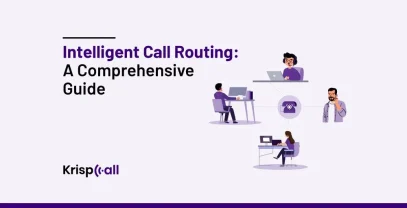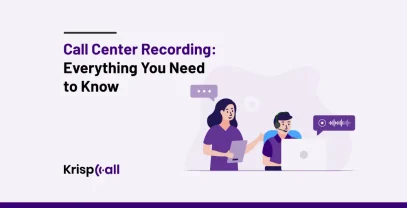Every day, a call center produces a large amount of data. These data can be about call details, each minute an agent spends on a phone call ☎️, customer feedback, or recorded calls.
It is necessary to record these data as they provide valuable insights 📈 into how your call center is performing.
This is where call center reporting comes in handy.
Call center reporting gathers data from a variety of call center activities, organizes it in one place, and provides insights into nearly everything that happens in your call center.
If you want to know more about call center reporting, how it works, best practices to implement it, key call center metrics, and its benefits, keep reading this blog.
What is Call Center Reporting?
Call center reporting is the process of collecting, analyzing, and presenting data related to agent performance, customer satisfaction level, and overall call center performance and efficiency in the form of reports.

In short, it is a report showing how well your call center performs. These reports can be generated on a daily, weekly, monthly, or yearly basis.
The reports are made based on several key call center metrics and Key performance indicators (KPI) such as:
- First Call Resolution (FCR): It is a KPI that measures a call center agent’s performance in resolving a customer’s issue on a first call.
- Average call wait time: It provides insights into the average time customers spend waiting for their calls to be answered by live agents.
- Average handle time: Average Handle Time is the measure of the amount of time the contact center agent spends on each call interacting with customers.
- Customer satisfaction level: This indicates how satisfied customers are with the products and services a business provides.
With these insights, managers can take proactive measures to streamline their business operations, boost agent performance, and enhance customer engagement.
What is a Call Center Reporting Dashboard?
A call center reporting dashboard is an intuitive dashboard in a phone system that displays information related to call center metrics and KPIs under a central location. In the reporting dashboard, data are presented in a graphical representation like a bar graph, pie chart, or percentage. Anyone can analyze information in seconds using the visual display.
How does Call Reporting Work?
Call reporting works through a combination of technology and human input to create a visual representation of call center workflow and agent performance.
Here’s a breakdown of the process:
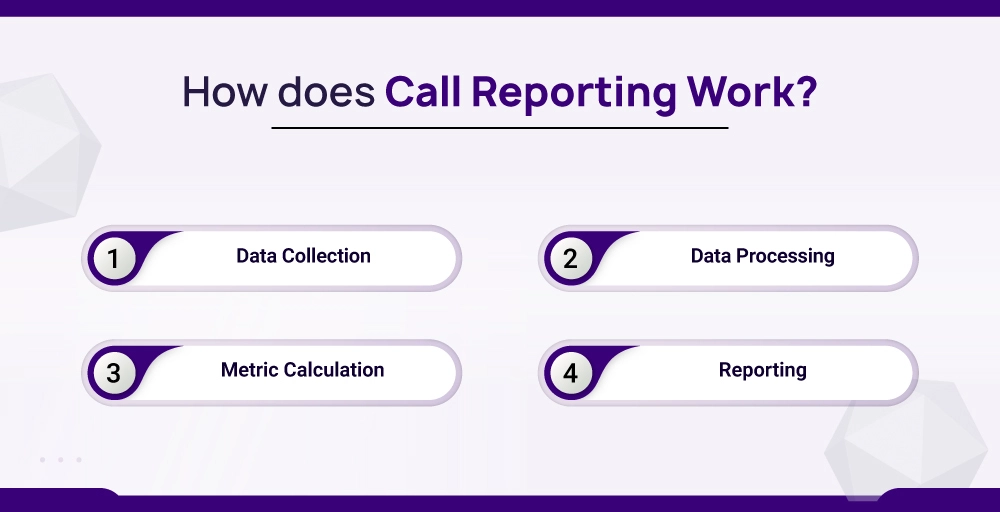
1. Data Collection
The call reporting system automatically collects data from various sources, such as Interactive Voice Response (IVR), Automatic Call Distribution (ACD), Customer Relationship Management (CRM) software, and Workforce Management (WFM) systems. The collected information can be about call details, call abandonment rate, call wait time, total number of answered and unanswered calls, etc.
2. Data Processing
Once the data is collected, it is assembled in a central location to extract relevant information. This involves filtering out unnecessary data, categorizing calls, and organizing the information for analysis.
3. Metric Calculation
In the third step, KPIs and other relevant metrics are calculated using different calculation methods. For example, average handle time is calculated by dividing the total call duration by the number of calls handled.
4. Reporting
Data and KPIs are presented visually using charts, graphs, and tables.
What are the Types of Call Center Reporting?
There are 3 types of call center reporting, namely call center-based reports, agent-based reports, and customer-related reports. Each type covers varied call center metrics and KPIs.
1. Call Center-Based Report
It is a type of call center reporting that measures the overall performance of a call center.
It covers the following aspects of call center metrics and KPIs:
- Number of inbound and outbound calls received and made in a given period.
- Total number of missed and abandoned calls
- Number of calls transferred to the internal department
- The call center’s ability to accommodate callers
- Service level agreements (SLA) adherence
- Overall call center performance
2. Agent-Based Report
This type of report provides data related to agent performance and their productivity. It covers the following aspects of call center metrics and KPIs:
- Number of calls handled by an agent
- Average handle time per agent
- Agent’s first call resolution rate
- Agents’ availability and occupancy
- Agent’s adherence to schedule
- Number of calls handled by agents at different skill levels
3. Customer-Related Report
This type of call reporting provides valuable data on customer engagement and satisfaction levels. It covers the following aspects of call center metrics and KPIs:
- Average time customers wait in the queue
- Number of calls resolved during the first interaction with an agent
- Level of service received by a customer
- Number of call transfers
- Customer satisfaction score
- Customer effort score
5 Best Call Center Reporting Software in 2024
1. KrispCall
The first best call center reporting tool on our list is KrispCall. With this reporting software, you can effortlessly gather crucial call center metrics, from live call stats (live calls, queued calls, and missed calls) to call distribution (total calls, total inbound calls, and total outbound in a day).
KrispCall call center reporting tool’s capabilities don’t stop there. It delves deeper, giving you valuable data on agent performance, like total number of calls they handle in a day, call duration with each client, call wait time, and call queue. You can gain insights into the most busy hours and days, enabling you to optimize resources accordingly.
In short, KrispCall empowers you with actionable insights into phone calls, call center performance, and agent performance, all within a user-friendly interface, making it the ultimate choice for your call center reporting needs.
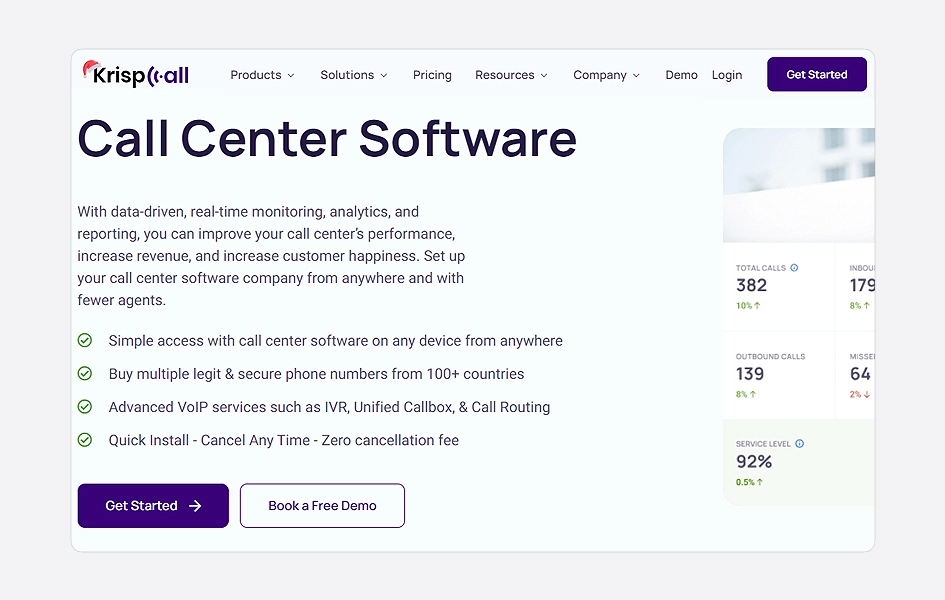
Besides call center reporting software, KrispCall also provides voicemail transcription software, automatic call distribution software, auto dialer software, virtual call center software, and inbound and outbound call center solutions.
Features:
- Built-in dashboard
- Call center performance report
- Call detail report
- Visual representation of data
Pricing:
| Essential | $15 per user per month |
| Standard | $40 per user per month |
| Enterprise | Custom pricing |
👍 Get a KrispCall Call Center Reporting Software Today
2. RingCentral
Another reliable call center reporting software is RingCentral. It is a business phone system provider offering a call center reporting tool as one of its products. This reporting software provides a wizard-based “point-and-click” interface for building and sharing report templates customized to your specific needs.
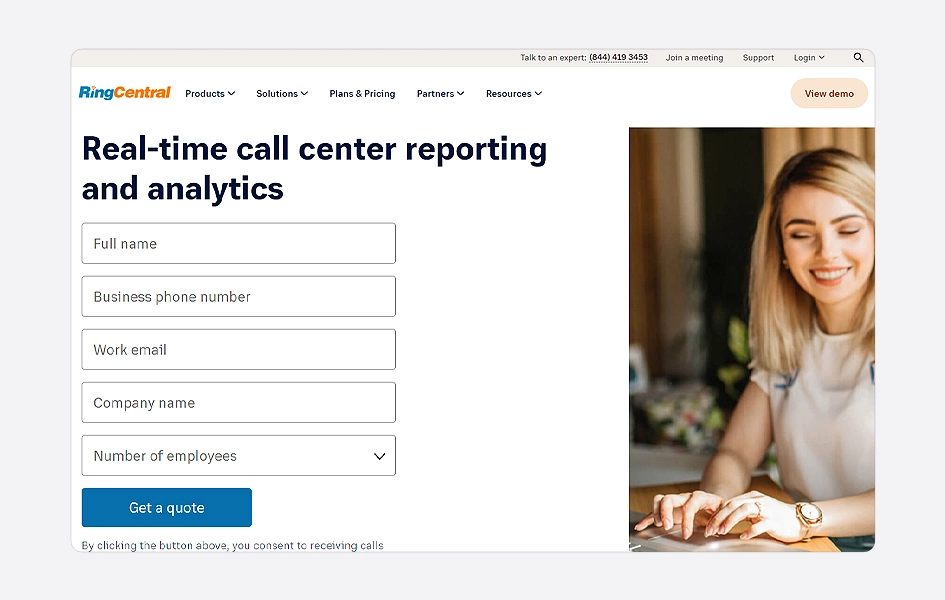
The notable feature of RingCentral’s reporting software is omnichannel reporting. You can use omnichannel reporting to track your efforts across all your channels from one place.
Feature:
- Omnichannel reporting
- Team performance report
- Pre-built report
- Report templates
Pricing: Contact Support Team
3. Nextiva
Another popular call center reporting tool you can trust is Nextiva. Nextiva is a blended contact center as a Solution (CCaaS) provider. It offers sales tools, service tools, phone systems, and social media management software, including a call center reporting tool.
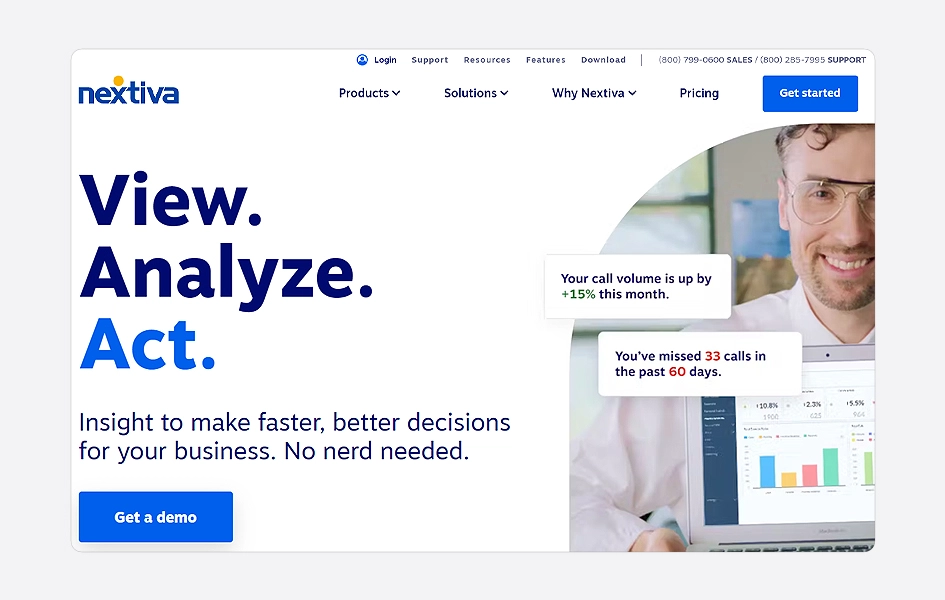
In the Nextiva reporting tool, you can view data on your agent performance, access call recordings directly from reports, and view and compare trends between time periods and employees.
Feature:
- Customize report and dashboard
- Call details Report
- Agent performance report
- Call recording data
Pricing: Contact the support team
4. 8×8
The fourth call center reporting software on the list is 8X8. With 8×8’s analytics and reporting tool, call center managers can customize reports to highlight the status of critical performance metrics. With this information on hand, they can optimize the customer experience.
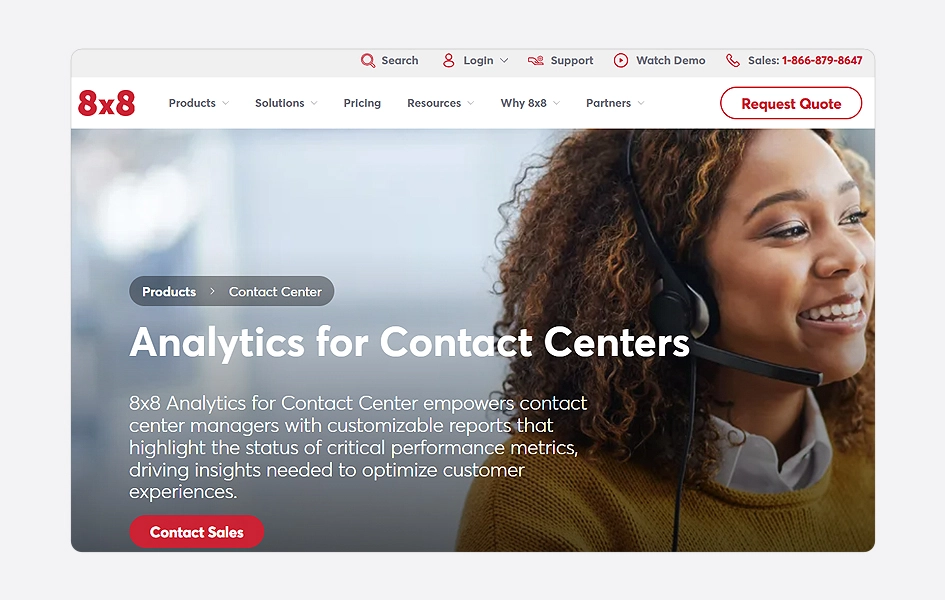
Moreover, you can export these reports into a spreadsheet file for archiving. Reports are divided into four types: agent interactions summary, queue interactions, agent status, and detailed reports.
Features:
- Customer experience analytics
- Speech analytics
- Omnichannel routing
- Call center workforce report
Pricing: Contact the support team
5. Voiptime
Last, you can also rely on Voiptime for the call center reporting tool. This reporting software comes with a detailed statistics report that gives you full details on your contact center workflow and processes.
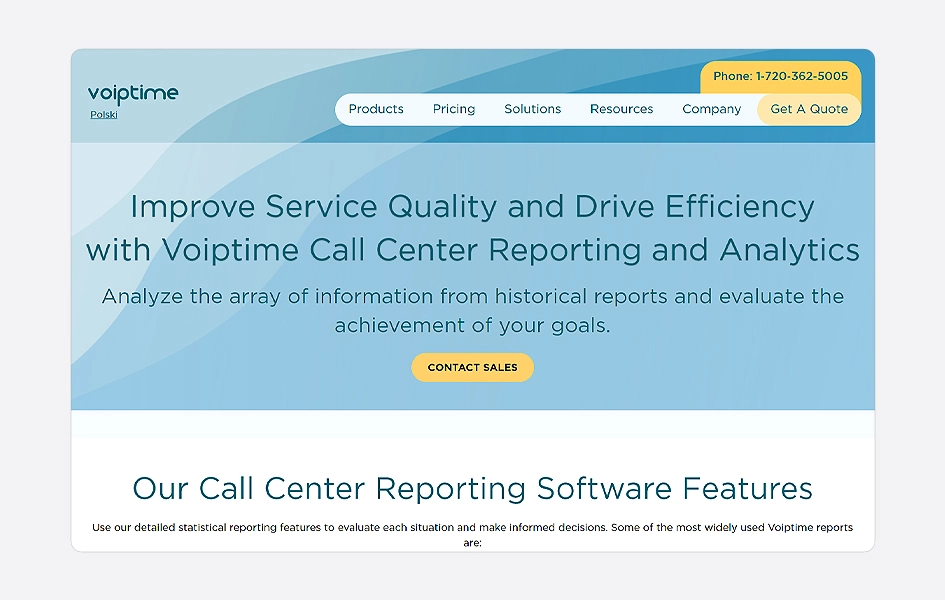
Additionally, it allows you to analyze campaign performance, see completed call scripts, and evaluate agent productivity and workload. Also, the important reports can be exported to .xlxs for further processing to receive the necessary data.
Features:
- Agent reporting
- Call Distribution Reports (CDR)
- Service Level (SL) Report
- Outbound Campaign Reporting
Pricing: Contact the support team
What are the Differences Between Call Center Reporting and Analytics?
Call center reporting and analytics go hand-in-hand. Hence, they are periodically used almost interchangeably. But they are not the same; both have their own distinct function. Reporting involves collecting raw data from call center activities, organizing the information for analysis, and converting it into simplified summaries.
On the other hand, analytics uses data from reporting to identify trends and patterns in the call center industry’s overall performance.
| Parameters | Call center reporting | Call center analytics |
| Purpose | It collects raw data and converts them into simplified summaries. | It identifies patterns and trends in the data presented |
| Real-time application | It answers the questions about “what’s happening” inside the call center. | It explains why it’s happening and what actions to take to improve it. |
| Method | It relies on call center metrics and KPIs to present data in the form of a report. | It uses advanced technologies like data mining, machine learning, and statistical analysis to explore data from different angles. |
| Output | Data organized in graphical data representation like charts, graphs, tables, and percentages. | A list of actionable insights and improvement suggestions. |
| Example | Call center reporting shows your team has a low First Call Resolution (FCR) rate. | With analytics, you can determine why such a low rate occurred and adjust your strategy accordingly. |
How to Create a Call Center Reporting Template for Your Business?
Creating a call center reporting template that resonates with your call center goals and objectives requires considering several factors. One simple mistake can ruin the whole reporting data.
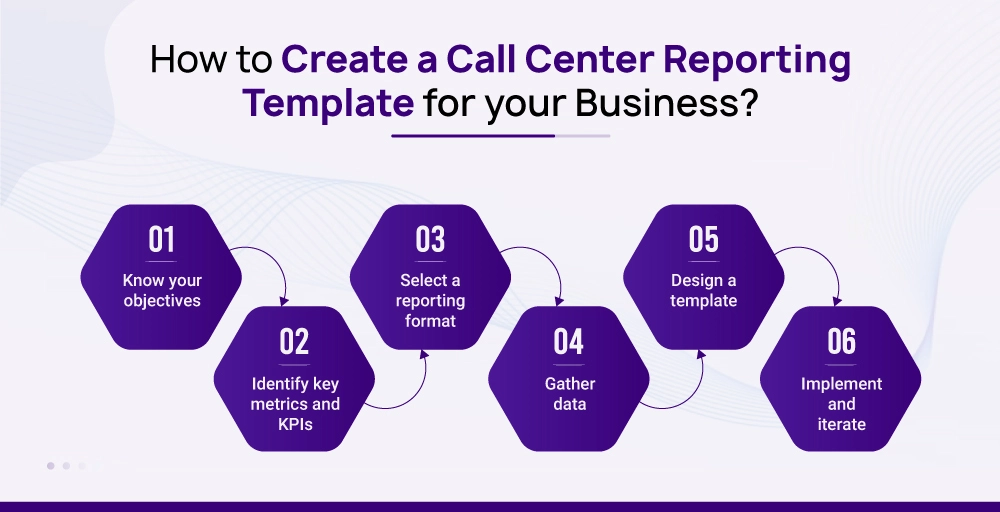
Below is the step-by-step guide to help you create a call center reporting template for your business:
- Know your objectives: Clearly know your reason behind creating a report and what you want to achieve with it. Is it for improving agent performance, optimizing resource allocation, boosting customer experience, or all?
- Identify key metrics and KPIs: Several call center metrics and KPIs are there. Choose metrics and KPIs that align with your objectives.
- Select a reporting format: Decide how you would like to present the data for easy comprehension and understanding. Do you want to show data in bar graphs, pie charts, tables, or something else?
- Gather data: You must know the sources from which you will gather data about call center activities. Is it from call recordings, Automatic Call Distributors (ACD), CRM software, Workforce Management Software, IVR, or others?
- Design a template: Design a template to organize your chosen metrics and KPIs visually appealing and systematically. Include varied sections for different parameters like call center performance, agent performance, call details, customer experience, and any other relevant areas.
- Implement and iterate: Input accurate data into your template and check if it came out as you wished. Determine if the data presented are easy to comprehend or not. Gather feedback from users and make adjustments if necessary. Also, it is crucial to regularly review and update the template to reflect changes in business goals or data sources.
What are the Call Center Reporting KPIs for Measuring Customer Satisfaction?
Some of the call center reporting KPIs for measuring customer satisfaction are as follows:
1. First Call Resolution (FCR)
It measures a contact center agent’s ability to resolve a customer’s queries or problems the first time they call. A higher FCR rate indicates a higher level of customer satisfaction. An industry standard for an ideal first-call resolution rate is 70% to 79%. Therefore, call centers with an FCR rate below 70% need to improve.
2. Average Abandonment Rate
The call abandonment rate measures the percentage of callers disconnecting prior to connecting with an agent. Higher abandonment rates signal customer dissatisfaction and displeasure. It is a vital metric for gauging customer satisfaction.
3. Average Wait Time (AWT)
It determines the time a customer waits before an agent answers their call. The higher AWT rate shows decreased customer satisfaction and the need to implement initiatives to decrease the average wait time.
4. Average Call Transfer Rate
This KPI measures how often an agent transfers a customer’s call to another agent who belongs to the same department or other department. The higher call transfer rate demonstrates call center agents’ inability to solve customers’ issues, leading to customer frustration and dissatisfaction.
Customer satisfaction can be improved by reducing the number of transfers or attempting to resolve the situation with the first agent.
5. Net Promoter Score (NPS)
The NPS demonstrates customer loyalty towards the business. It examines how likely customers will recommend your service to others. You can use this metric to determine whether the call center is providing good customer service.
The higher NPS scores indicate higher customer loyalty, while lower scores indicate reduced customer loyalty.
6. Service Level
The service level KPI measures the level of service that customers receive. Service level can be measured by the 80-20 rule (80% of calls are answered within 20 seconds). It is possible to increase customer retention and satisfaction by maintaining a consistent level of service.
7. Customer Satisfaction Score (CSAT)
CSAT measures customer satisfaction with the service provided by a call center. It directly shows how well the call center is meeting clients’ expectations.
8. Customer Effort Score (CES)
It is a call center KPI that measures customer effort in interacting with your call center. In addition, it also measures how easy it is for customers to use your product or service and find needed information. Call centers can use this information to improve their products and customer support services.
What are the Major Benefits of Call Center Reporting for your Call Center Operation?
Call center reporting offers valuable insights on agent performance, customer satisfaction, and overall efficiency.
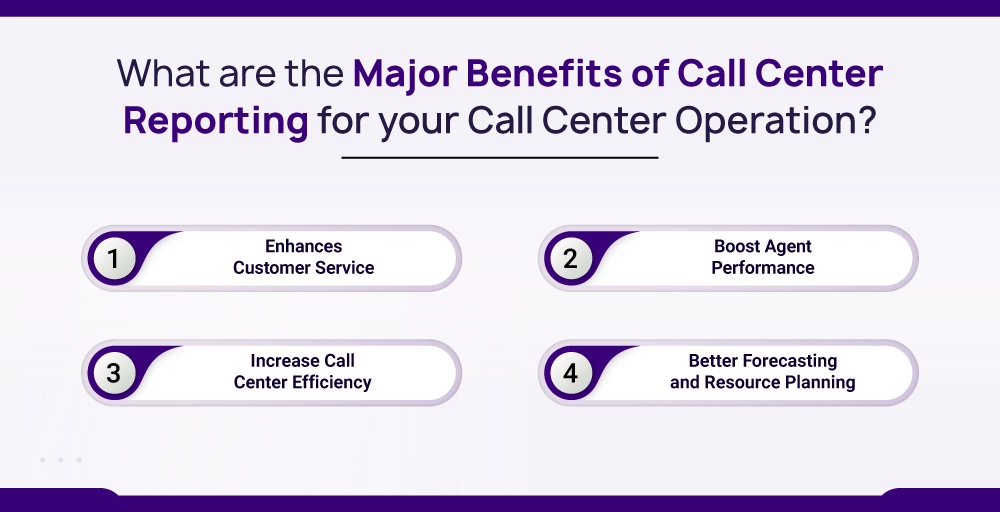
You can use this information to make data-driven decisions that enhance customer service, boost agent performance, increase efficiency, reduce costs, and plan for the future.
1. Enhances Customer Service
Call center reporting plays a crucial role in assessing customer satisfaction and sentiment. KPIs like First Call Resolution, call abandonment rate and call transfer rate provide deep insights into customers’ pain points and overall customer experience. With this information on hand, call centers can take the necessary steps to serve them better and improve their experience.
2. Boost Agent Performance
A call center reporting tool allows the call center to monitor various aspects of agent performance in real-time. Metrics like average wait time, number of calls handled, resolution times, and missed calls during business hours provide valuable insights into individual agent activities.
This real-time monitoring enables managers to offer targeted training programs in order to improve agent skills.
3. Increase Call Center Efficiency
As agents become more adept at handling calls, the overall efficiency of your call center is positively impacted. Additionally, KPIs like service level and predictive analytics such as Net Promoter Score (NPS) provide insights into your call center operations as a whole. The data obtained from these insights can be used to implement changes in your operations.
4. Better Forecasting and Resource Planning
By examining records of call volumes, peak hours, and call volume patterns, you can predict expected call volumes accurately. This allows you to effectively plan your staffing needs and optimize agent schedules.
What are the Best Practices for Effective Call Center Reporting?
You must strictly follow some best practices to get the most benefits from your call center reporting. These best practices include:
- Define your Key Performance Indicators (KPIs)
The KPIs we discussed above do not apply to every contact center. Hence, it is essential to select the KPIs that are most important for your contact center. You can select KPIs based on your business type, goals, areas you are trying to improve, and what’s crucial for your success.
- Use real-time monitoring tools
Reporting involves collecting real-time data. Hence, you must use real-time monitoring tools that provide current data on what’s happening in your call center. This enables managers to locate what’s going well, spot issues quickly, and decide on things like staffing allocation, training, or process adjustments.
- Customize Reports to Your Needs
It’s crucial to create customized reports focusing on the metrics most relevant to your call center’s performance and objectives. This will help you leverage maximum benefits from reporting. Additionally, it is essential to create reports that cater to the needs of stakeholders such as managers, team leaders, or executives.
- Regularly Review and Update Reports
Continuously reviewing and updating your reports is essential. This ensures that they remain in line with evolving business goals, changing customer expectations, and industry trends.
- Ensure Data Accuracy
Besides reviewing and updating updates, it is vital to audit and verify the accuracy of the data used in your reports. Inaccurate data can result in wrong analysis, leading to wrong decisions made on this basis.
- Provide Actionable Insights
Reports should not only present data but also should offer actionable insights. Therefore, it is essential to include analysis and recommendations for improvement based on the data presented in the reports.
Final Words
One of the best ways to measure the overall call center performance is through call center reporting. It not only gives details on the number of calls made and received by a call center but also provides valuable insights into how call center agents are performing, how satisfied customers are with the products and services of the company, and the areas that need improvements.
If call center reporting is maintained consistently, then it will aid in enhancing customer service, boosting agent performance, and increasing call center efficiency. So, what are you waiting for? Get a Cloud call center solution like KrispCall that provides built-in reporting and analytics dashboards along with several other advanced communication features.
FAQs
What are the major challenges for call center reporting?
Call center reporting faces several major challenges while composing reliable reports. These challenges make it difficult to get maximum benefits from reports. Here are some major challenges:
- Data accuracy: keeping data accurate and reliable is a consistent challenge. It requires regular monitoring and auditing.
- Integration issues: Integrating data from various sources can be difficult because of limited knowledge and incompatible systems.
- Real-time reporting complexity: Real-time reports need advanced systems to process data instantly.
- Defining relevant KPIs: It’s often tricky to identify and define useful KPIs, as they change based on the industry and goals.
- Customization and flexibility: It’s difficult to compose reports that cater to the needs of different groups of people, such as managers, team leaders, or executives.
- Interpreting and acting on data: It’s hard to pull out helpful information and make changes based on what the data tells us.
How does call center reporting help to reduce operation costs?
Call center reporting helps to reduce operation costs in two ways:
- Firstly, by analyzing agents’ performance through KPIs like average call handle time, first call resolution, number of calls handled and missed, etc, managers can train them effectively. This builds a team of skilled agents who can handle calls efficiently. It eliminates the need to hire extra staff to handle call volume, reducing operation costs.
- Secondly, cost-related KPIs like cost per call and average handle time shed light on how much you spend on each call. With this information, you can take strategic actions to reduce overall call costs. These actions include allocating resources more efficiently, negotiating for better rates with phone service providers, and implementing self-service options to reduce call costs.
List out the emerging trends in Call Center Reporting.
The emerging trends in call center reporting include the use of Artificial Intelligence (AI) in analytics, omnichannel integration, and personalized reporting.
What are the mistakes that you need to avoid while implementing Call Center Reporting?
The most dangerous mistakes that you need to avoid while implementing call center reporting include:
- Not updating data regularly.
- Monitoring all KPIs which may or may not be relevant to your business goals.
- Ignoring human error.
- Not leveraging technology to automate repetitive tasks.
- Ignoring customer feedback.
- Ignoring agent feedback.
- Relying on built-in reports instead of customizing reports that suit your requirements.
- Not defining sources of data.



